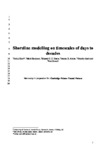Shoreline modelling on timescales of days to decades
| dc.contributor.author | Hunt, Emily | |
| dc.contributor.author | Davidson, M | |
| dc.contributor.author | Steele, E | |
| dc.contributor.author | Amies, J | |
| dc.contributor.author | Scott, T | |
| dc.contributor.author | Russell, Paul | |
| dc.date.accessioned | 2023-02-01T13:24:38Z | |
| dc.date.issued | 2023-02-01 | |
| dc.identifier.issn | 2754-7205 | |
| dc.identifier.issn | 2754-7205 | |
| dc.identifier.other | e16 | |
| dc.identifier.uri | http://hdl.handle.net/10026.1/20224 | |
| dc.description.abstract |
Climate change is resulting in global changes to sea level and wave climates,which in many locations significantly increasethe probability of erosion, floodingand damage to coastal infrastructure and ecosystems.Therefore, there isa pressing societal need to be able to forecast themorphological evolution of our coastlines over a broad range of timescales, spanningdays-to-decades, facilitating more focussed, appropriate,and cost-effective management interventions and data informed planning to support thedevelopment of coastal environments. A wide range of modelling approaches have been used with varying degrees of success to assess both the detailed morphological evolution and/or simplified indicators of coastal erosion/accretion.This paper presents an overview of these modelling approaches, covering the full range of the complexity spectrum, summarising the advantages and disadvantages of eachmethod. A focus is given to reduced-complexity modelling approaches, including models based on equilibrium concepts, which have emerged as a particularly promising methodology for the prediction ofcoastal change over multi-decadal timescales. The advantages of stable, computationally-efficient, reduced-complexity models must be balanced against the requirement for good generality and skill in diverse and complex coastal settings. Significant obstacles are also identified, limiting the generic application of models at regional and global scales. Challenges include: the accurate long-term predictionof model forcing time-series in a changing climate, and accounting for processes that can largely be ignored in the shorter term but increase in importance in the long-term.Further complications include coastal complexities, such asthe accurate assessment of the impacts of headland bypassing. Additional complexities includecomplex structures and geology, mixed grainsize,limited sediment supply, sources and sinks. It is concluded that with present computational resources, data availability limitations and process knowledge gaps, reduced-complexity modelling approaches currently offer the most promising solution to modelling shoreline evolution on daily-to-decadal timescales. | |
| dc.language | en | |
| dc.language.iso | en | |
| dc.publisher | Cambridge University Press (CUP) | |
| dc.subject | 13 Climate Action | |
| dc.title | Shoreline modelling on timescales of days to decades | |
| dc.type | journal-article | |
| plymouth.volume | 1 | |
| plymouth.publication-status | Published | |
| plymouth.journal | Cambridge Prisms: Coastal Futures | |
| dc.identifier.doi | 10.1017/cft.2023.5 | |
| plymouth.organisational-group | /Plymouth | |
| plymouth.organisational-group | /Plymouth/Faculty of Science and Engineering | |
| plymouth.organisational-group | /Plymouth/Users by role | |
| plymouth.organisational-group | /Plymouth/Users by role/Academics | |
| plymouth.organisational-group | /Plymouth/Users by role/Post-Graduate Research Students | |
| dcterms.dateAccepted | 2023-01-26 | |
| dc.rights.embargodate | 2023-2-3 | |
| dc.identifier.eissn | 2754-7205 | |
| dc.rights.embargoperiod | Not known | |
| rioxxterms.versionofrecord | 10.1017/cft.2023.5 | |
| rioxxterms.licenseref.uri | http://www.rioxx.net/licenses/all-rights-reserved | |
| rioxxterms.type | Journal Article/Review |


